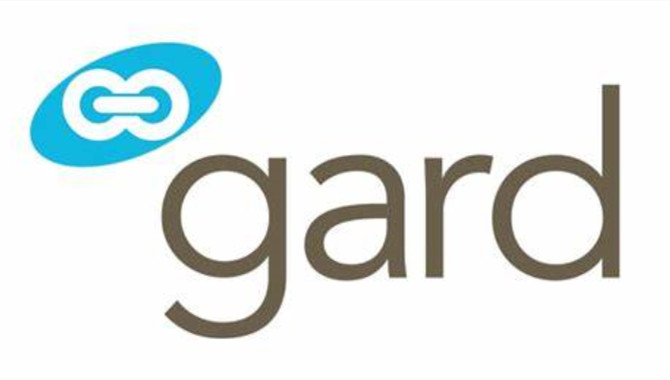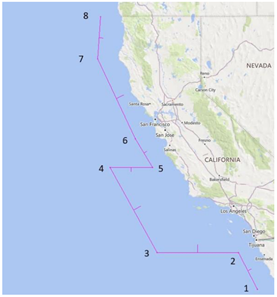
On 16 November 2021, the Ports of Los Angeles and Long Beach introduced a new queuing process for Container Ships. On 10 January 2022, it was expanded to San Francisco Bay Area for the port of Oakland. The purpose was to increase safety and improve air quality by reducing the number of vessels at anchor or loitering in the area by allowing the vessels to slow steam across the Pacific and optimize voyage transit time after departing from the previous port and heading towards Los Angeles, Long Beach and the San Francisco Bay Area.
Old and the new queuing process
The process before the change was to assign container vessels into the arrival queue based on actual arrival time when crossing a line 20 nautical miles from the San Pedro Bay Port Complex or if heading to Oakland then crossing a line 80 nautical miles from the coast.
Under the new process, vessels will be added to the queuing list based on when they depart from their last port of call before Los Angeles, Long Beach, or Oakland. Vessels will then be prioritized on the list based on their calculated time of arrival. The intended benefit of the new system is that vessels can slow steam and spread out across the Pacific rather than crowd into congested waters while they await a berth.
Safety and Air Quality Area
As part of the program aimed at enhancing air quality the Marine Exchange of Southern California and San Francisco Bay Region, a Safety and Air Quality Area (SAQA) was demarcated as show below.
The Safety and Air Quality Area is defined as the area shoreward of the lines between the following coordinates:
1. 30-20N 117-00W
2. 32-00N 118-00W
3. 32-00N 122-20W
4. 35-45N 124-50W
5. 35-45N 122-35W
6. 37-00N 123-30W
7. 40-18N 125-30W
8. 42-00N 125-20W

This area is approximately 50 miles west of the coast of Central California and 150 miles west of Southern California to remain clear of the missile test ranges.
Container vessels are to remain outside the Safety and Air Quality Area (SAQA) until 72 hours prior to reasonable expectation of berthing time. The procedures are intended to address current port congestion and may change as congestion decreases. Our correspondent for Los Angeles and Long Beach reports that congestion has significantly reduced following the new quelling procedures.
Main challenges posed by drifting mid sea
Heavy weather: Gard has handled many claims where heavy weather was identified as one of the main contributory factors. Most typical ones being damage to hull & machinery, and container stack collapses. The consequences of heavy weather can be more severe if the mariners are not aware of the approaching conditions or underestimate them.
Navigational safety: Drifting with other vessels in close vicinity could pose a navigational risk. Alertness of the bridge team can also drop if vessels drift for extended periods of time.
Shortage of bunkers: Vessels may face shortage of bunkers if the drifting period extends beyond what has been planned as this unforeseen excess bunker consumption may not have been accounted for during the voyage.
Recommendations
• A careful watch on the development of weather should be maintained so that the vessel may take adequate precautions well in advance, including deciding on moving away from the area. Vessels can enter the SAQA for the safety of the ship during a storm or in an emergency.
• Mariners should be made aware of the recommendations contained in USCG's “Heavy Weather Advisory: Winter Weather Update” which will remain effective till 1 April 2022. Some of the more noteworthy recommendations mentioned are:
• A distance of three nautical miles should be maintained from other vessels
• Propulsion plant should be ready for immediate use
• Vessels are reminded not to unjustifiably display Not Under Command (NUC) lights and shapes or change the status of the Automatic Identification System (AIS) to NUC while drifting, unless they are unable to manoeuvre as required by the collision regulations
• Vessels may need to re-evaluate their reserve bunker quantities to avoid bunker shortage issues during extended waiting period. Entry into the SAQA is allowed for bunkering as well as other routine ship operational needs, for example, crew changes and loading ship stores.
• Owners, Managers and Charterers are encouraged to go through the FAQ document prepared by the Marine Exchange of California, the link to which we have provided below.
• Local agents should be contacted if the vessels or their managers have any questions related to the new queuing process.
Source: Gard
The opinions expressed herein are the author's and not necessarily those of The Xinde Marine News.
Please Contact Us at:
media@xindemarine.com



 Ningbo Containerized Freight Index Weekly Commentar
Ningbo Containerized Freight Index Weekly Commentar  Ningbo Containerized Freight Index Weekly Commentar
Ningbo Containerized Freight Index Weekly Commentar  Ningbo Containerized Freight Index Weekly Commentar
Ningbo Containerized Freight Index Weekly Commentar  BIMCO Shipping Number of the Week: Bulker newbuildi
BIMCO Shipping Number of the Week: Bulker newbuildi  Ningbo Containerized Freight Index Weekly Commentar
Ningbo Containerized Freight Index Weekly Commentar  Ningbo Containerized Freight Index Weekly Commentar
Ningbo Containerized Freight Index Weekly Commentar